April 27, 2018
Air Date: April 27, 2018
FULL SHOW
SEGMENTS

Pruitt Under Fire On Capitol Hill
View the page for this story
EPA Administrator Scott Pruitt faces allegations of legal and ethical violations, including allegedly illegal spending on a soundproof phone booth and a cozy condo deal with an energy lobbyist. Democrats recruited a record number of federal lawmakers for a joint resolution calling for a cabinet resignation – 39 Senators and 140 House members. Republicans won’t sign, though some also want him out. Senator Tom Udall (D-NM) is leading the push and tells host Steve Curwood he’s frustrated by the lack of oversight in the Republican-led Congress, and concerned by EPA’s regulatory rollbacks that he says endanger Americans’ health. (08:34)
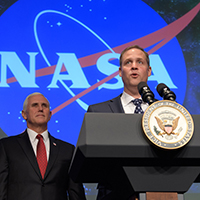
Beyond the Headlines
/ Peter DykstraView the page for this story
This week, Peter Dykstra and Host Steve Curwood go Beyond the Headlines to discuss NASA’s new anti-climate action Administrator and a girl scout’s journey to Washington to protest the weakening of coal ash regulation. In the history lesson, they consider the influence of Michael Mann’s famous “hockey stick” graph that dramatically depicts CO2 levels rising in lockstep with global temperatures. (04:17)

Science Note: Sea Urchins Eat Rocks
/ Aynsley O'NeillView the page for this story
Sea urchins help create their own homes by chewing up the rocks they live on. As Aynsley O’Neill reports in this week’s Note on Emerging Science, Purple sea urchins can create as much sediment as a river would deposit. (01:35)
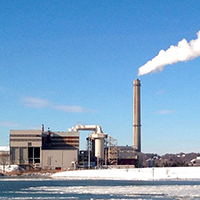
Wasting a Wetland With Trash Ash
/ Bobby BascombView the page for this story
In the 1950s and 60s landfills were often sited in wetlands, land too soggy for farming or houses. That use would be illegal in the US today and many have been shutdown. However, the Massachusetts Department of Environmental protection recently gave the green light to uncap part of a waste incinerator landfill in an estuary north of Boston and add half a million more tons of toxic ash. Living on Earth’s Bobby Bascomb reports. (13:26)

American Bittern: Master of Camouflage
/ Mary McCannView the page for this story
In marshes across North America, if you look carefully and listen for a loud gulping sound on spring mornings you might spot an American Bittern. In this week’s BirdNote®, Mary McCann describes its striped plumage and how its behavior helps it blend with the cattails. (02:09)
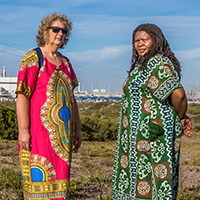
Goldman Prize Winners Block Secret Nuclear Plant Deal
View the page for this story
Two of the seven winners of the 2018 Goldman Environmental prize were a team of grassroots activists from South Africa. Their efforts quashed a secret deal between Russia and the South African government to build expensive and wasteful nuclear power plants. Liz McDaid and Makoma Lekalakala tell host Steve Curwood how they were able to derail the shadowy project, and why they believe with an abundance of sunlight and wind, nuclear has a minimal role in South Africa’s energy profile going forward. (14:59)
Show Credits and Funders
Show Transcript
HOST: Steve Curwood
GUESTS: Tom Udall, Liz McDaid, Makoma Lekalaka
REPORTERS: Peter Dykstra, Aynsley O’Neill, Bobby Bascomb, Mary McCann
[THEME]
CURWOOD: From Public Radio International, this is Living on Earth.
[THEME]
CURWOOD: I’m Steve Curwood. EPA Administrator Scott Pruitt is under heavy fire for alleged legal and ethical violations, and a record number of lawmakers say enough is enough.
UDALL: Our resolution is truly historic. It represents the most Senators to ever sign onto a resolution calling for a cabinet official's resignation. The resolution sends a clear message: The American people have no confidence in Scott Pruitt, and it's time for him to go.
CURWOOD: Also, folks who live along the North shore of Boston love their neighborhood – but not the toxic ash landfill in the marsh….
JEWKES: It’s a beautiful estuary. We have all kinds of birds that nest here. We have turtles, we have seals that come in the river. I mean it’s beachfront property, it just comes with the downfall of having a trash incinerator across the street.
That and more this week on Living on Earth – Stick Around!
[NEWSBREAK MUSIC: Boards Of Canada “Zoetrope” from “In A Beautiful Place Out In The Country” (Warp Records 2000)]
[THEME]
Pruitt Under Fire On Capitol Hill

Scott Pruitt’s days as EPA Administrator could be numbered. Many lawmakers have called for him to resign, and 10 federal inquiries are underway into his security practices, travel expenses and other issues. (Photo: Gage Skidmore, Flickr CC BY-SA 2.0)
CURWOOD: From PRI, and the Jennifer and Ted Stanley Studios at the University of Massachusetts, Boston, this is Living on Earth. I’m Steve Curwood. Republican support to seems to be waning for EPA Administrator Scott Pruitt, under fire for lavish spending and alleged legal and ethical violations. Calling some of Mr. Pruitt’s actions and reported misappropriations quote ‘indefensible,’ Republican senator John Kennedy of Louisiana told Politico, ‘You just can’t put lipstick on those pigs. You can’t.’
And while a number of other Republicans, including Mr. Pruitt’s powerful patron Oklahoma Senator James Inhofe have raised questions about the EPA chief, the majority still remain silent. Not so for most Hill Democrats. As we record this, some 140 House members and 39 senators, all caucussing with Democrats, have signed on to a non-binding resolution introduced by Representative Kathy Castor of Florida and Senator Tom Udall of New Mexico calling for Mr. Pruitt’s resignation. Senator Udall’s resolution states Mr. Pruitt is unfit for office, not only for apparent legal and ethical lapses, but also for policies that fail to protect the environment.
UDALL: Our resolution is truly historic. It represents the most Senators to ever sign onto a resolution calling for a Cabinet official's resignation. The resolution sends a clear message: The American people have no confidence in Scott Pruitt, and it's time for him to go.
CURWOOD: Congress can’t fire Administrator Pruitt without going through the full impeachment process so practical politics says his tenure is in the hands of President Trump. And Senator Udall says every day Mr. Pruitt remains on the job, Americans are endangered.
UDALL: Well, first of all in the public health arena and the worker safety arena, he's very bad. In the water resources area, he has major problems there, and air quality ... real problem. So, these are things that I have cared about from the beginning of my public service. I will keep fighting for them. Unfortunately, we have a person in the office of administrator of the EPA who does not care about them. He's working against us, and he's doing so in such a way that he's hurting millions of Americans right where it hurts in terms of public health, worker safety and air quality.
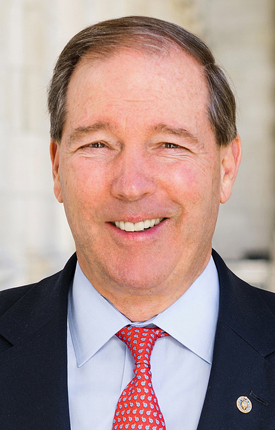
Senator Tom Udall (D-NM) has served in the U.S. Senate since 2009. (Photo: Office of Senator Tom Udall)
CURWOOD: Now, what's your view of the opinion held by some that Mr. Pruitt took the job so he could specifically do the bidding of industry? The chemical industry is concerned about rules. The energy industry concerned about global warming and so on and so forth – that he was put there to unwind as many possible regulations and responsibilities as possible.
UDALL: Well, that has been the president's policy. As you know, the president had a very strong policy in terms of undermining what he called the deep state. My view of the deep state is these are career scientists and public health people who really want to do right by the American people. So, he got his assignment from the President and then here he is, a state attorney general who spent his whole time suing the EPA. He comes in, and my understanding is 59 of the top positions, one-third of those are filled by people from the industry, that worked in the industry, and now they're on the regulatory side and there's been very little disclosure and I think there are some real ethical problems there on that too.
CURWOOD: Now, to what extent do you think that administrator Pruitt has violated the law? What's he doing that's illegal in your view?
UDALL: Well, the General Accounting Office has announced that the $43,000 soundproof booth in his office was a violation of law, and they are referring that further down the line, and we are going to follow closely what the outcome is there. I think it's clear as a matter of law he should have notified the Congress if he was going to spend that kind of money, so that Congress could have had some input. But he didn't, and he broke the law.
CURWOOD: How has his perceived ethical lapses compromised his ability to do his job, do you think?
UDALL: Well, I don't think there's any doubt that his ability to do his job is compromised because of his ethics. He seems to be willing to push the envelope on almost everything he's doing, especially ethical behavior. For example, he chose a lobbyist to rent a house from in Washington for $50 a night when in that particular area anybody running a room would cost $150, and the lobbyist had an issue before his agency, the EPA. Very questionable behavior.
CURWOOD: Now, Senator, all the signers of your resolution are Democrats, yet there are some Republican lawmakers – I'm thinking of Frank LoBiondo of New Jersey, Carlos Curbello who heads the climate caucus there in the House, and a couple of other Republicans have also called for Administrator Pruitt to resign or be fired. Why didn't the resolution gain their support? Why not make this bipartisan?
UDALL: Members on both sides of the aisle know we need a new EPA administrator. We're expressing that in a number of different ways. This resolution is just one of the ways. As you know, Frank LoBiondo of New Jersey came out in support of Pruitt resigning, Susan Collins in the Senate. The numbers are growing and we anticipate at some point the Republicans will start joining our sense of the Senate resolution.
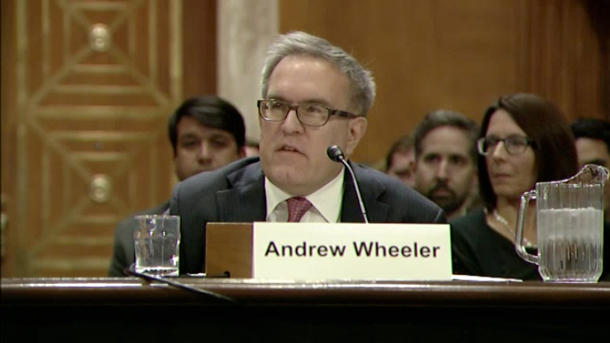
Andrew Wheeler testifying before the Senate Committee on Environment and Public Works, Wednesday, November 8, 2017. Wheeler, a former coal lobbyist, was confirmed by the Senate on April 12, 2018 as the second-in-command under Scott Pruitt. (Photo: Senate Committee on Environment and Public Works)
CURWOOD: Now, one of the Republicans said Congresswoman's Stefanik of New York said that she didn't think that these resolutions would be brought up certainly on the House side. How true is it that the speaker and majority leader won't move to let this be voted?
UDALL: I think in the Republican Congress, they are very reluctant to take on President Trump. They would much rather protect him by not holding hearings, by not bringing up resolutions that could be embarrassing, and they're not doing their oversight. The big problem here is that Congress is supposed to do oversight of the executive branch, and that means regardless of party, you step up to the plate, you do your job. They aren't doing their jobs in this circumstance.
CURWOOD: Now, Senator, under the Constitution actually, Mr. Pruitt could be removed by Congress if he were found guilty of a crime. How possible is that, or is that just beyond the pale politically right now?
UDALL: Well, I think the more likely course will be that the Republicans will visit with the Trump White House and say this guy's been around too long, he's hurting us, you've got to get rid of him. We know there have already been a lot of those discussions, I know that privately talking to Republicans. In the White House right now there have been discussions about Pruitt leaving. They haven't reached the point that we think they should, but I think it's building and I think this has a snowball effect. As soon as we compile a somewhat complete list, more issues come out. I just can't believe he's still there to tell you the truth.
CURWOOD: How did this happen? How did a man like Scott Pruitt become head of the Environmental Protection Agency? How did we get there?
UDALL: Well, it all flows from President Trump. He clearly was indicating that many of the regulations that are in place, many of the laws that are in place. He was going to do everything he could to stand on the industry side, and that's why they thought up this term, the deep state, and they said, well, we're going to destroy the deep state and we're going to do everything we can to make sure that business is now in charge of the agenda, which I think is a is a very unfortunate place to be, especially for American citizens who looked to this agency when it was set up, bipartisan signed into law by President Nixon. There was this huge expectation that the Environmental Protection Agency would do the good work protecting the American people, and really we have a president and an administrator who aren't interested in that.
CURWOOD: Senator Tom Udall of New Mexico has served in the United States Senate since 2008. Senator Udall, thanks so much for taking the time with us today.
UDALL: Thank you very much.
Related links:
- The Resolutions calling for Administrator Pruitt’s resignation (S.Res.473/H.Res.834)
- POLITICO: “Pruitt Dodges Blame”
- The New York Times: “Expenses, Emails and a Phone Booth: The Investigations Faced by Scott Pruitt”
- Bloomberg: “White House Deterring Republicans From Defending Pruitt, Sources Say”
- The Washington Post: “Senate confirms a former coal lobbyist as Scott Pruitt’s second-in-command at EPA”
- POLITICO: “The Myth of Scott Pruitt’s EPA Rollback”
- The New York Times: “Scott Pruitt Before the E.P.A.: Fancy Homes, a Shell Company and Friends With Money”
- About Senator Tom Udall
- Read about the Udall family’s legacy of environmental protection
[MUSIC: Geoff Muldaur, “Wild Ox Moan” on The Secret Handshake, by Vera Hall and Ruby Pickens Tartt, Hightone Records]
Beyond the Headlines
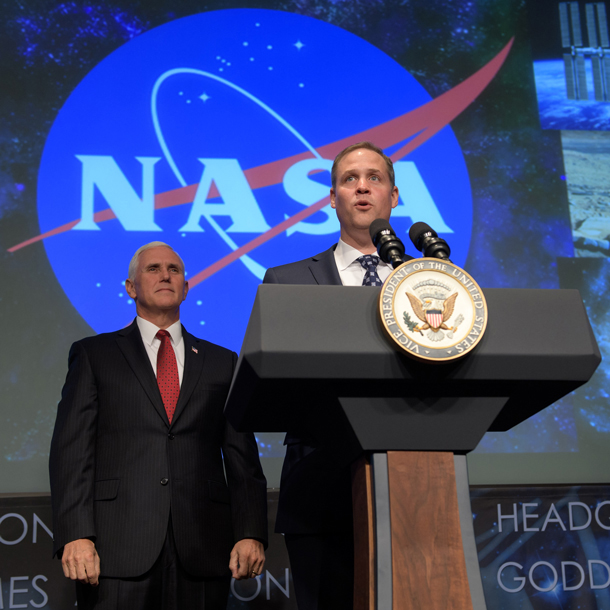
Jim Bridenstine was sworn in into office as NASA’s Administrator by Vice President Mike Pence on April 23, 2018. (Photo: NASA HG PHOTO, Flickr BY NC-ND 2.0)
CURWOOD: Let’s take a look Beyond the Headlines now with Peter Dykstra, he’s down in Atlanta where he’s, well, when he’s not talking to us he’s busy working as an editor for Environmental Health News, that ehn.org and DailyClimate.org. Hi there Peter, what’s going on?
DYKSTRA: Hi Steve, well there’s a new administrator for NASA this week and its Congressman Jim Bridenstine, a three-term representative from Oklahoma, who rejects the consensus on climate change and has also been very critical of what is now his own agency, NASA, spending money on climate change.
CURWOOD: Well wait, NASA has a huge earth observation component. In fact, perhaps one of the most famous climate scientists, James Hansen, was a NASA employee for a number of years. What’s going on?
DYKSTRA: That’s right, but science has nothing to do with Jim Bridenstine. He has no science credentials or background. The closest he comes is an enthusiasm for science. And he ran the Tulsa Air and Space Museum in his hometown back in the day.
CURWOOD: Hey what’s with Tulsa anyway?
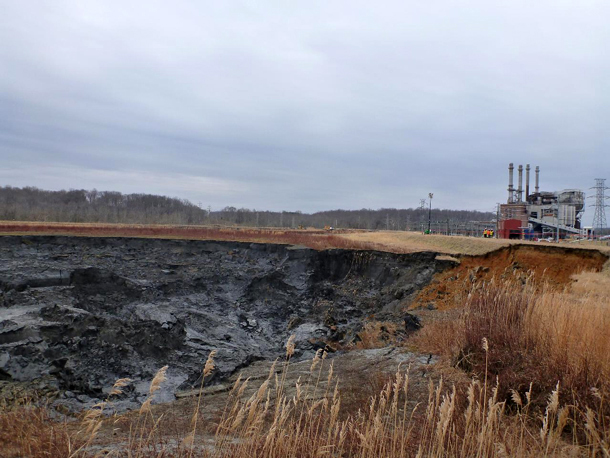
A coal ash impoundment like the one above is threatening Amelia Hopkins’ Girl Scout camp on Lake Springfield in Illinois – so the 7th grader is traveling to Washington to press EPA to keep regulations on coal ash in place. (Photo: U.S. Environmental Protection Agency)
DYKSTRA: Well Tulsa has been kind of a breeding ground for – I guess the word would be anti-environmentalists. There’s Jim Bridenstine and his climate denial. There’s Scott Pruitt and his notorious term at EPA. Scott Pruitt started his political career as a state senator representing Tulsa. And of course, Jim Inhofe, the uber-climate-denying Senator who was at one time the mayor of Tulsa and later its Congressman.
CURWOOD: Hmm, I wonder if there’s something in the water down there.
DYKSTRA: I’d be surprised if there weren’t something in the water down there with leaders like that.
CURWOOD: [LAUGHS] Hey what else do you have?
DYKSTRA: Let’s talk some more about EPA. The agency has angered journalists by shutting off access to its information. They’ve angered scientists by firing its staff scientists. They’ve infuriated activists. But now they’ve really done it, EPA has cheesed off the Girl Scouts.
CURWOOD: Oh, how’s that? They’re not buying the cookies?
DYKSTRA: Well there’s a summer camp in Illinois for Girl Scouts that’s possibly threatened by leaks from a coal ash impoundment. Coal ash regulations were tightened up by the Obama administration. The Trump administration has proposed loosening those regulations. And one girl scout in particular is travelling from her central Illinois troop to Washington, hopefully to earn a badge by talking to the EPA about those coal ash regs, keeping them tight and protecting their summer camp.
CURWOOD: Hey this is great, I mean it seems like youth activism is not only taking on climate, it’s taking on guns and now, coal ash.
DYKSTRA: Well I think it’s really cool to see young people, and in this case a very young girl scout, participating in democracy when they see something that threatens their beliefs.
CURWOOD: Ok now what do you have from the oldie by goodie department that is history?
DYKSTRA: We’re going to talk about somebody whose been a guest here on Living on Earth and talked to you on several occasions, that’s Michael Mann the climate scientist. And it was 20 years ago this month that the first version of his “hockey stick” graph was published.
CURWOOD: Now of course the hockey stick because when you plot the data of temperature and CO2 together, for a long time it’s flat and that was of course like the shaft of a hockey stick. Then you come to fairly modern times and it suddenly goes up and that’s like the blade of hockey stick. And I guess that’s the point.
DYKSTRA: That’s right and his theory and his graph have been validated and vindicated by science again and again and again over the last couple decades. It’s been attacked by climate deniers again and again and again. And Michael Mann has borne up well against it all.
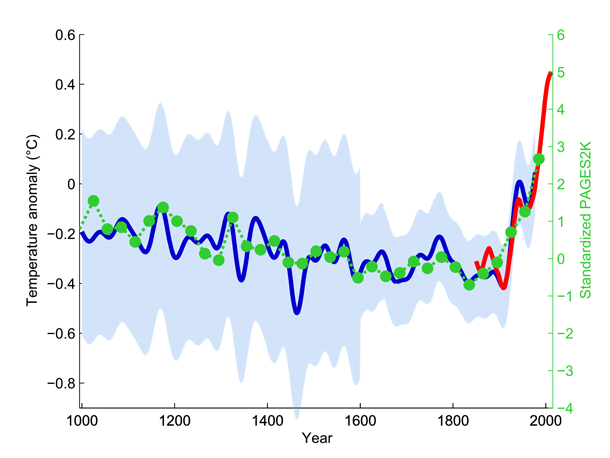
The “hockey stick” temperature anomaly. The dark blue shows climate scientist Michael Mann’s data with an uncertainty range in light blue; the red curve shows the global mean temperature since 1850; and the green dots show data from the PAGES 2k project. More info at this link. (Image: Klaus Bittermann, Wikimedia Creative Commons)
CURWOOD: And there you go. When you use real science, you get real results.
DYKSTRA: Not only that but he’s the most prominent climate scientist to actively fight back against the attacks from climate deniers. He’s done so in court, he’s done so in the court of public opinion and he’s done so in books and other publications, including in an article in Scientific American this past week on the 20th anniversary.
CURWOOD: Ok Peter, well, thank you for taking this time with us today and I look forward talking with you again real soon.
DYKSTRA: Alright, Steve, we’ll talk to you soon, thanks.
CURWOOD: And if you’re listening and you’re curious about some of these stories, you can head on over to our website loe.org.
Related links:
- Vox: “Trump’s next NASA administrator is a Republican congressman with no background in science”
- Illinois Homepage: “Girl Scouts to press EPA on coal ash”
- Scientific American: “Earth Day and the Hockey Stick: A Singular Message” by Michael Mann
CURWOOD: Next time on Living on Earth – we begin our three part series about Kerala the lush tropical state in India, where education is high, incomes are modest and many link troubling rates of cancer to pesticides on imported vegetables. More and more middle class families are growing their own organic food.
MANU: We decided to call all our family here and we made food out of what we’d grown from our terrace. We’ll have boiled rice, and there would be a curry that is called a sambah, so it would be a complete vegetarian feast.
CURWOOD: Taking toxics out of food in India— in the weeks ahead on Living on Earth.
[MUSIC: Jacqueline Schwab, “True Blue Waltz” on True Blue Waltz, by David Cahn, Midsummer Recordings]
CURWOOD: Coming up, sea creatures that eat rocks! That’s just ahead on Living on Earth, keep listening!
ANNOUNCER: Support for Living on Earth comes from the Gordon and Betty Moore Foundation, and from a friend of Sailors for the Sea, working with boaters to restore ocean health.
[CUTAWAY MUSIC: Lewis Porter-Phil Scarff Group, “Raga Bhairavi, Part 2,” on Three Minutes To Four, traditional Indian/arr.Phil Scarff, Whaling City Sound]
Science Note: Sea Urchins Eat Rocks
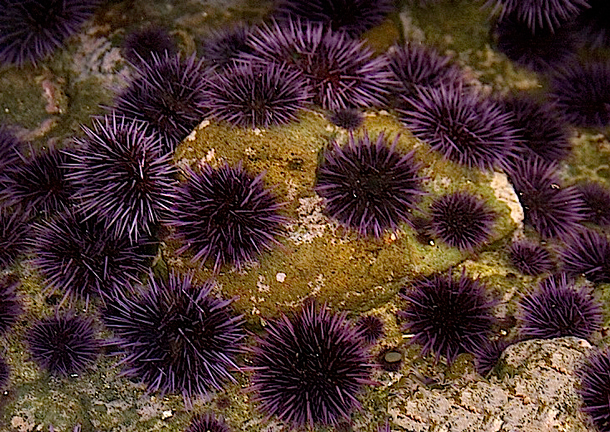
Purple sea urchins (Strongylocentrotus purpuratus), such as these photographed in the intertidal zone of Willows Beach on Santa Cruz Island off the coast of California, can produce amounts of sediment on par with the average river every year. (Photo: Gregory “Slobirdr” Smith, Flickr CC BY-SA 2.0)
CURWOOD: It’s Living on Earth, I’m Steve Curwood. Coming up, a seaside town fights the dumping of toxic incinerator waste that puts residents and wildlife at risk.
But first this note on emerging science from Aynsley O’Neill.
[SCIENCE NOTE THEME]
O’NEILL: Many beachgoers are likely to be familiar with sea urchins: colorful, spiny invertebrates found on rocky reefs around the world. Typically, each sea urchin lives nestled in a rock pit that’s the perfect size, leading scientists to believe that they carve out their own little rock homes.
But until recently, there was no experimental proof of this. So researchers at the University of Villanova recreated the standard sea urchin habitat, a rocky costal reef, within a lab.
They carved dozens of flat surfaces of sandstone, mudstone, and granite, three types of rock from California’s coast, where the urchins live. Then they placed individual purple sea urchins on each surface. As these urchins fed on their typical diet of the algae growing on the rocks, it became clear that they were also eating the rock itself.
Over the course of a year, each of the flat rocks became measurably less heavy, though the granite and mudstone showed little-to-nothing in the way of noticeable pit formation. By analyzing the relationship between the laboratory rate of erosion and the density of sea urchins in the wild, researchers determined that for every acre they cover, these hardy animals create over 40 tons of sediment every year – and that’s roughly equivalent to the annual sediment load deposited by a medium sized river. Quite a feat for an animal with no legs.
That’s this week’s note on emerging science. I’m Aynsley O’Neill.
[SCIENCE NOTE THEME]
Related links:
- The original purple urchin study article in PLOS One
- The University of Villanova press release on the purple urchin findings
Wasting a Wetland With Trash Ash
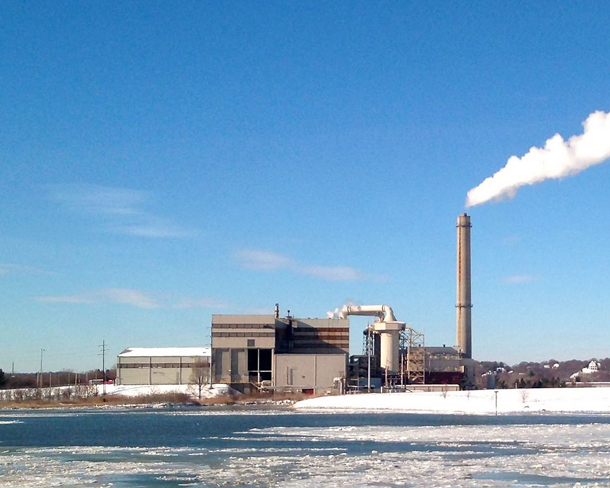
The Wheelabrator Saugus waste-to-energy plant. (Photo: Fletcher6, Wikimedia Commons CC BY 3.0)
CURWOOD: There are some 1000 waste incinerator landfills across the country, many built in the 1950s, 60s and 70s and sited in marshes and estuaries, then seen as a good spot to dump trash, since they were useless for housing or farming. Landfills that take toxic fly ash from waste incinerators wouldn’t be approved there today, since we understand how critical wetlands are as wildlife habitat and buffers from coastal storms. But many have been grandfathered in, including a 1950’s landfill in Saugus, Massachusetts, slated for closure in 1996, but still operating.
Now the Massachusetts Department of Environmental Protection has given the green light to allow an additional half million tons of carcinogenic fly ash and bottom ash to be dumped there. It’s a leaky unlined landfill, sitting in an estuary, in an area prone to flooding. Living on Earth’s Bobby Bascomb has our story.
[WAVE AND WATER SOUNDS]
BASCOMB: In the first week of March 2018, when the moon was full, a Nor’ Easter dumped torrential rains on the coast north of Boston and each high tide brought a new round of flooding for communities there. Revere Resident, Kelly Lampedecchio shares videos of the flooding in her neighborhood on Facebook.
[SOUNDS OF SPLASHING WIND AND RAIN]
LAMPEDECCHIO: Ok, we’re at high tide.
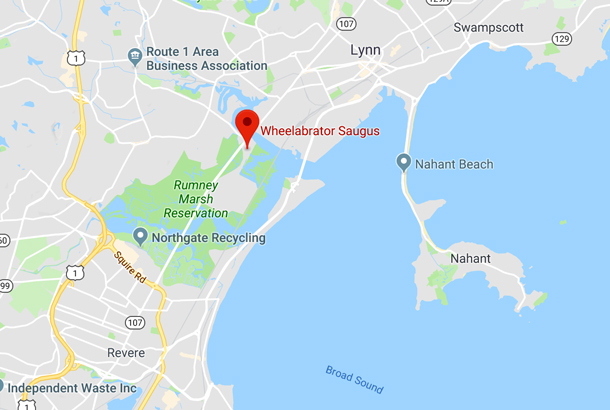
The Wheelabrator Saugus waste incinerator and landfill are located inside the Rumney Marsh Reservation, near the Atlantic Ocean. (Image: Google Maps)
BASCOMB: The water is ankle deep in her backyard. Out front, the street is completely submerged and water creeps up the front steps towards her door. Every house on the street is sitting in water.
LAMPEDECCHIO: The guardrail is completely gone. That’s a dock that floated over from the boatyard. The neighborhood has totally disappeared.
BASCOMB: It’s a lot of water but Sandra Hurly Jewkes and other residents of Revere say they are used to flooding here.
JEWKES: When we get a flood tide here this house becomes an island. It happens, I’m going to say, 5-7 times a year.
BASCOMB: Sandra called me during the storm from her mom’s house, which sits on a narrow spit of land between Rumney Marsh and Massachusetts Bay – the Atlantic Ocean. She says three generations of her family have lived here, in the house her grandfather built.
JEWKES: It’s a beautiful estuary. We have all kinds of birds that nest here. We have turtles, we have seals that come in the river. I mean, it’s beachfront property, it just comes with the downfall of having a trash incinerator across the street.
BASCOMB: That trash incinerator – and the landfill next to it – belong to a company named Wheelabrator Technologies. They own more than a dozen waste facilities across the country.
JEWKES: When the tide comes in and we get these flood tides the landfill and Wheelabrator become an island also, they are cut off from land. It’s water on both sides. So the water is literally lapping right up on the landfill itself.
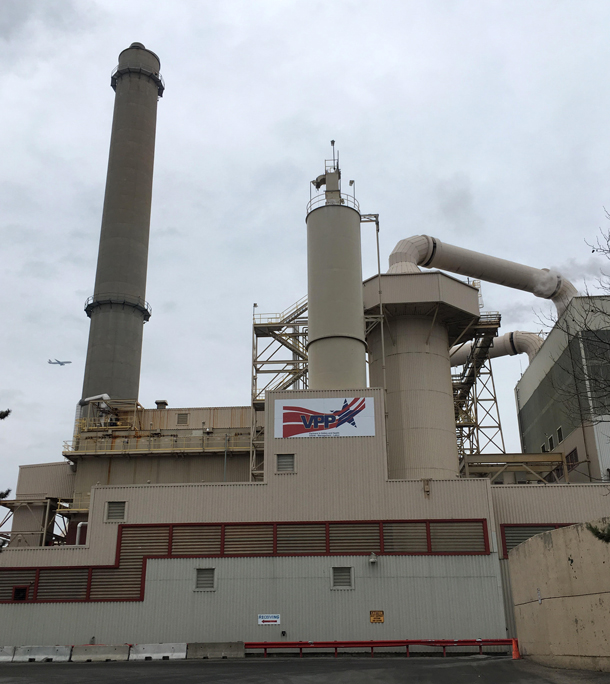
Part of the Wheelabrator Saugus waste incinerator. (Photo: Bobby Bascomb)
BASCOMB: And it’s the landfill that really concerns local residents like Sandra. It’s the repository for fly ash and bottom ash – that’s the material that doesn’t actually burn up during waste incineration. It contains a cocktail of heavy metals and toxic chemicals – mercury, cadmium, arsenic, lead, and dioxins. For every 4 tons of trash burned, 1 ton of ash is left behind and it has to go somewhere.
[AMBIENT SOUND OF WAVES, PLANES OVERHEAD]
BASCOMB: Elaine Hurley, Sandra’s mother, stands in a restaurant parking lot in Revere overlooking the landfill. Revere and the surrounding cities are working class, industrial communities. Elaine says she remembers back before there were scrubbers on the incinerator when all the toxic chemicals went out the smoke stack and straight into the air, a stone’s throw from her home.
HURLEY: When they started burning the fly ash would come in my house. On the windowsill it was like a black soot all the time and you run your finger it was like greasy. It actually ate the paint off the side of my car that was parked towards it.
BASCOMB: Elaine Hurley says she’s relieved to have cleaner air but concerned about what the chemicals that ate the paint off her car could do to the marsh if they leach out of the landfill.
HURLEY: We’ve gone over there, we’ve videotaped the marsh where the water leaches out. No vegetation. It’s all dead. So, what’s the affects on the fish? You know? What’s the affects on the ducks?
BASCOMB: The landfill sits literally inside the Rumney Marsh, which was declared an area of critical environmental concern in 1988. It’s a vitally important habitat for local and migrating species – an oasis in an industrial area. Planes leaving Logan airport fly over every two to three minutes. A busy highway borders the estuary on one side and it’s surrounded by development on the other sides – houses, gas stations, dry cleaners and so on.
Joan LeBlanc of the Saugus River Watershed Council stands behind a Dunkin’ Donuts next to a pile of lobster traps and looks out at the estuary.
[SOUNDS OF SEA GULLS AND TRAFFIC]
LEBLANC: In the spring when the fish come in, the rainbow smelt, alewives and all sorts of other fish come in from the ocean to feed and to migrate. In the summer time you’re going to see all manner of shore birds as well as migrating birds so great blue herons, snowy egrets. There are also mammals; you have river otters, you have musk, coyotes even sometimes.
BASCOMB: She says any chemical contaminants in the marsh will bioaccumulate up the food chain to eventually contaminate more species, including humans that eat fish.
LEBLANC: These are the type of issues that keep me up at night.
BASCOMB: Research suggests that by the end of the century there will be one and a half to two feet of sea level rise in this area. Joan LeBlanc says sea level rise coupled with frequent coastal storms makes the incinerator landfill particularly vulnerable.
LEBLANC: So, yes we are really concerned about the future. And if there were some kind of major breach in a storm here with this ash landfill and that were to empty into the marsh, I just don’t know how or if you would be able to clean that up.
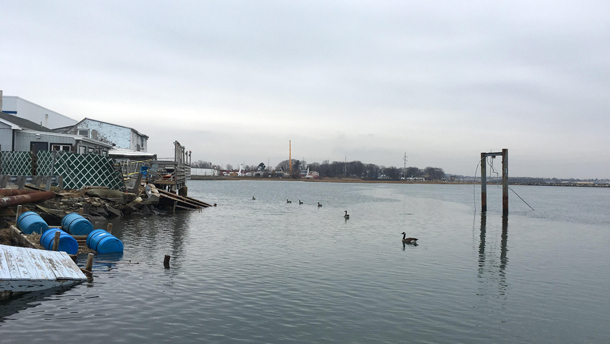
Located in an industrial community, the Rumney Marsh is designated an area of critical environmental concern. (Photo: Bobby Bascomb)
BASCOMB: Most of the landfill is currently capped and from afar looks like a grassy hill, there’s even a bird sanctuary on part of it. But the Massachusetts Department of Environmental Protection recently gave the green light for Wheelabrator to tear the cap off 39 acres of the facility, so they can dump roughly half a million tons of additional incinerator waste into two valleys originally designed for storm water runoff.
Kirstie Pecchi is director of the zero waste project with Conservation Law Foundation. She says the MassDEP decision to expand the capacity of the landfill is especially egregious because the landfill doesn’t have a plastic liner.
PECCI: Here there just happens to be clay because when you dig a hole in a marsh you’re going to hit clay. There was not a clay liner constructed as far as I can tell, ever.
BASCOMB: The landfill, built in the 1950s, pre-dates the federal law that requires such facilities to have a proper plastic liner. But Pecci says even if this facility did have a plastic liner it would likely still leak.
PECCI: Because the waste is caustic. That’s going to eat through a plastic liner or poke through sooner or later. So even if this were plastic lined I’d say we need to be testing what’s escaping the landfill.
BASCOMB: And that’s another controversial point. This is the only incinerator landfill in Massachusetts where the state does not routinely sample groundwater as required by federal law. Pecci, of the Conservation Law Foundation, says Wheelabrator’s own graphs show that the bottom of the landfill is actually resting in water.
PECCI: So, there’s no way to keep the contamination from entering the marsh because it’s in the water. By definition it’s going to spread through the water.
BASCOMB: To find out why they aren’t testing the ground water as required by federal law I made many requests to speak to Wheelabrator Facilities, the Massachusetts governor’s office, and the Massachusetts DEP, Department of Environmental Protection. They all turned me down. The DEP suggested I talk to the Environmental Protection Agency region 1, which overseas Massachusetts. But the EPA referred me back to the MASS DEP.
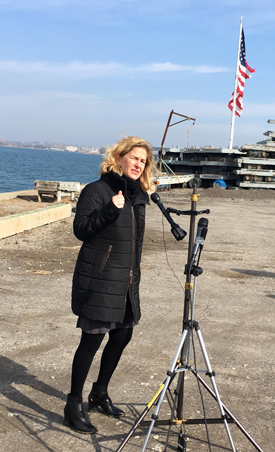
Kirstie Pecci of the Conservation Law Foundation speaks to a group of reporters and residents just across the marsh from the Wheelabrator facility. (Photo: Bobby Bascomb)
In an e-mail, Ed Coletta, a spokesman for MassDEP, explained that instead of taking water samples near the facility they rely on a slurry wall to contain the landfill. They measure the pressure both inside and outside the wall with a piezometer. As long as the pressure is higher outside the wall than inside, they assume any leachate is contained inside the landfill. But resident Sandra Hurley Jewkes says that is no substitute for actually taking water samples near the facility.
JEWKES: I think they aren’t taking them because they don’t want to know.
BASCOMB: Other residents like Elle Baker are frustrated that Wheelabrator spends lavishly to buy good will in the community, but won’t pay for ground water samples or an environmental impact report.
BAKER: If they are willing to write checks for little league, for tree lighting, for other things like this in the community why not for an environmental impact report because that is truly being a good neighbor. That’s truly proving to us the community that maybe … maybe it’s not as dangerous. But they don’t want that to happen. They don’t want to provide that to the community and that’s what’s concerning.
BASCOMB: The only official willing to speak to me about this issue was State Representative Rose Lee Vincint.
VINCENT: I’m determined to make sure that we do whatever we can to, you know, stop this injustice.
BASCOMB: Representative Vincent has introduced legislation to close the Wheelabrator landfill twice.
VINCENT: It’s just so wrong, how anyone can look at it and think it’s not wrong? Instead of realizing it was wrong but now we can try to do something to fix it, let’s try to mitigate and make it safe. What they want to do though is make it bigger, they don’t want to make it safe.
BASCOMB: Vincent says she is worried about the potential health effects on the community where four generations of her family have lived, where she raised her own children.
VINCENT: My children don’t live here but someone’s children live here now. But it’s not just about my children it’s about everyone’s children. Some day some kids should be able to go fishing in that water.
BASCOMB: Because water samples aren’t taken, there’s no way to know what chemical pollutants or how much might be leaking into the estuary from the landfill. But scientists like George Thurston know what they would expect. Thurston is Director of the Program in Exposure Assessment and Human Health Effects at the NYU School of medicine and has served on the National Academy of Science’s Committee on the Health Effects of Waste Incineration.
THURSTON: Our committee, when we looked at this for the National Academy of Sciences, we identified cadmium, arsenic, mercury and lead as some of the components of particles that were of most health concern.
BASCOMB: He says exposure to those types of pollutants can have serious health effects over time.
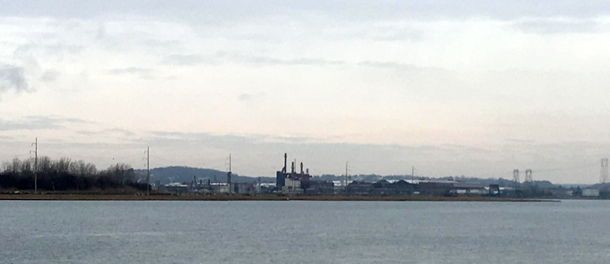
The Rumney Marsh is an area prone to flooding. (Photo: Bobby Bascomb)
THURSTON: Cumulative long-term exposures can increase risk of cancer.
BASCOMB: According to the Massachusetts Cancer Registry, the communities near the facility do have elevated rates of certain cancers including leukemia, testicular cancer, and cancer of the larynx. George Thurston says that’s all the more reason to be careful when permitting more potential exposures. And opening up a capped landfill is inherently more dangerous than leaving the facility closed.
THURSTON: But I would say any time you open up one of these capped facilities then that would increase risk of some sort of accident and getting a release. The biggest concerns are when things don’t go as they should and you need continuous monitoring to determine that.
BASCOMB: Thurston has another practical piece of advice – avoid the problem to begin with.
THURSTON: Well, my input on this would be to try to minimize the trash in first place. By emphasizing recycle and composting we can really reduce waste in our society tremendously. Make the facility basically obsolete and unnecessary. I mean that’s … as a society that’s what we should be trying to do.
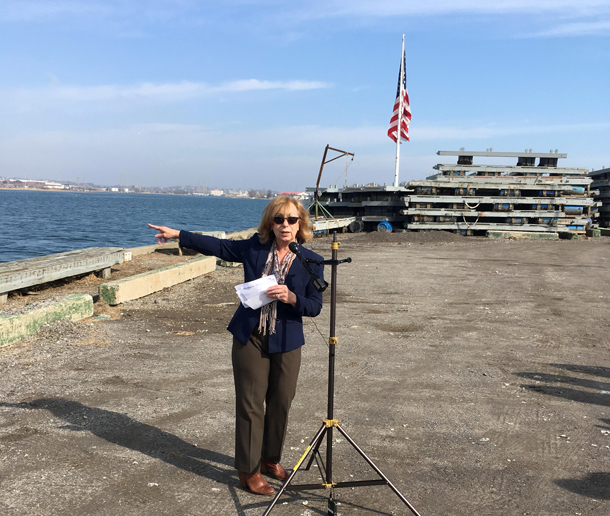
State Representative Rose Lee Vincent points to the Wheelabrator waste incinerator and landfill. (Photo: Bobby Bascomb)
BASCOMB: Wheelabrator burns roughly 123,000 tons of municipal waste annually from 10 Massachusetts communities. The company estimates that roughly 80% of the trash could actually be recycled or composted. So consumers have a role in reducing the need for trash incinerators and their landfills.
But for now incinerators continue to burn up our waste and Wheelabrator has the go-ahead to uncap the Saugus landfill and add more toxic ash. Community and environmental groups opposed to the DEP’s decision say all options are on the table to stop that from happening, including appealing the decision in court.
Related links:
- Conservation Law Foundation -about Wheelabrator Incinerator
- Massachusetts Department of Environmental Protection -about Wheelabrator Incinerator
- Wheelabrator Saugus Incinerator-company site
- Saugus River Watershed Council concerns about Wheelabrator Incinerator
- Statement from Alliance for Health and Environment about Wheelabrator Incinerator
American Bittern: Master of Camouflage

An American Bittern in flight. (Photo: Gregg Thompson)
[BIRDNOTE® THEME]
CURWOOD: We stay in a marsh for today’s BirdNote, where Mary McCann introduces us to an iconic shy member of the heron family – with an extraordinary voice.
BirdNote®
American Bittern - Master of Camouflage
[American Bittern’s “oonk-a-loonk” calls, repeated]
One fine, spring morning as you walk near a marsh, you are stopped in your tracks by a loud, reverberating call, with a cadence that seems lifted from an old cartoon soundtrack.
[American Bittern’s “oonk-a-loonk” calls, repeated]
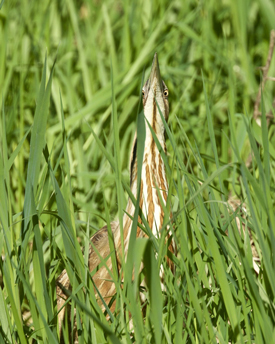
An American Bittern freezes and holds its head and neck upward in an attempt to blend in to the marsh grasses. (Photo: Gregg Thompson)
You scan the cattails, but it seems this comical sound has an invisible source.
[American Bittern’s “oonk-a-loonk” calls, repeated]
Then, after a long moment, into an opening in the cattails, walks what looks like a good-sized heron, but with a mottled brown back and bold brown stripes running the length of its very long neck. You are looking at an American Bittern, a member of the heron tribe that spends much of its time in the dense cover of the reeds. Bitterns are masters of camouflage. Not only does their striped plumage perfectly imitate surrounding vegetation, but for further concealment, they freeze, holding their heads and necks upward at an angle that mimics the reeds. I’m Mary McCann.
[American Bittern’s “oonk-a-loonk” calls, repeated]
###
Written by Bob Sundstrom
Call of the American Bittern provided by The Macaulay Library of Natural Sounds at the Cornell Lab of Ornithology, Ithaca, New York. Recorded by S.R. Pantle.
Producer: John Kessler
Executive Producer: Chris Peterson
© 2005-2018 Tune In to Nature.org April 2018 for LOE Narrator: Mary McCann
http://birdnote.org/show/american-bittern
Related links:
- This story about the American Bittern on the BirdNote® website
- Learn more about the American Bittern: Cornell Lab of Ornithology’s All About Birds
CURWOOD: Paddle on over to our website, loe dot org, for photos and more.
Your comments on our program are always welcome. Call our listener line anytime at 617-287-4121. That's 617-287-4121. Our e-mail address is comments at loe dot org. – comments at loe dot org. And visit our web page at loe dot org. That's loe dot org.
[MUSIC: Glen Velez, “Pan Eros” on Pan Eros, CMP Records]
CURWOOD: Coming up, a pair of prize-winning, environmental heroes who stopped a secret plan for a costly nuclear power plant in South Africa. That’s just ahead here on Living on Earth, stay tuned.
ANNOUNCER: Funding for Living on Earth comes from you our listeners, and United Technologies - combining passion for science with engineering to create solutions designed for sustainability in aerospace, building industries and food refrigeration. UTC companies such as Otis, Carrier, Pratt & Whitney and UTC Aerospace Systems are helping to move the world forward. You can learn more about United Technologies by tuning in to the Race to 9 Billion podcast, hosted by UTC’s Chief Sustainability Officer. Listen at raceto9billion.com. That’s raceto9billion.com. This is PRI, Public Radio International.
[CUTAWAY MUSIC: Phil Scarff, “Raga Yaman, Drut Tintaal” on Ragas on Saxophone, traditional Indian/arr. Phil Scarff, Galloping Goat Records]
Goldman Prize Winners Block Secret Nuclear Plant Deal
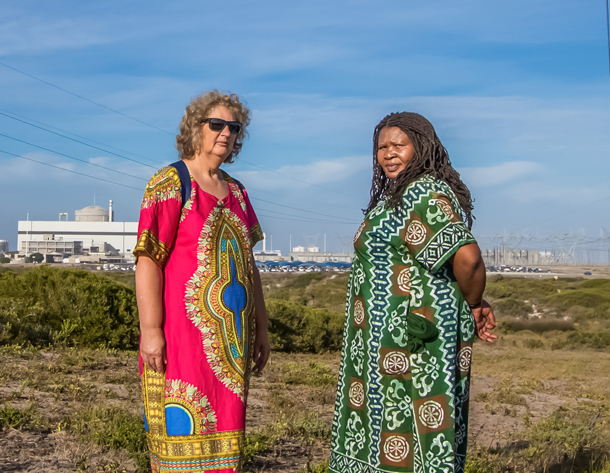
Liz McDaid (left) and Makoma Lekalakala (right) near the Koeberg Nuclear Power Station, which dates from apartheid South Africa's nuclear weapons program era in the 1970's. (Photo: Goldman Environmental Prize)
CURWOOD: It’s Living on Earth, I’m Steve Curwood. Every year, we feel honored to celebrate the Goldman Environmental prize winners, extraordinary brave souls who stood up to vested interests, corruption, political repression and industry bullying to protect their homes and environment. This year’s winners are as courageous as ever – and have proved equally as effective.
A prize is awarded to activists in each inhabited region of the world, and today, we’re joined by the winners from Africa, Makoma Lekalakala and Liz McDaid. These women are long-time community activists who joined forces to push back against a secret nuclear power deal forged between South Africa and Russia. It was crafted behind closed doors but eventually stalled because the two launched a lawsuit that blocked the project on the grounds of improper collusion for this $76 bn project. Welcome to Living on Earth, Makoma and Liz!
MCDAID: Thank you very much.
LEKALAKALA: A pleasure.
CURWOOD: So, tell me about this secret nuclear deal. How did you come to learn of its existence?
MCDAID: Well it was Earthlife Africa. Makoma actually got a tipoff from one of their partners in Russia. In terms of the energy plan that the plan had been manipulated to include nuclear energy when scientifically, if you had to look at it, it wasn't necessary. So and it certainly seemed there was something going down on the nuclear deal. So, when the story broke that this deal had been signed, it was a vindication of something we had a suspicion about.
LEKALAKALA: Because this was something that should have never happened. Our government should have never signed that intergovernmental agreement. We come from a past where we fought so hard to bring about the democratic dispensation that we live in, and if things happened that we were against, still happen within what we call it democratic dispensation, that was wrong.
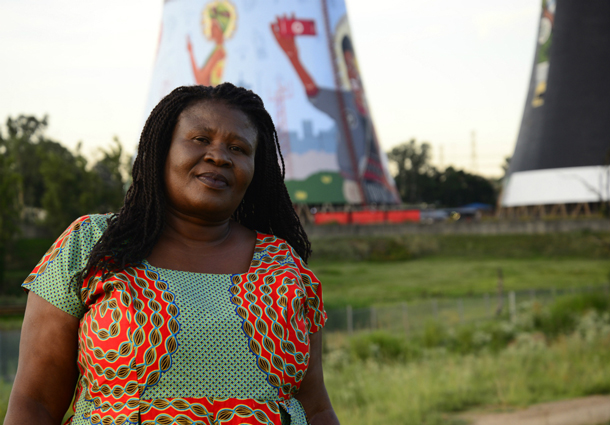
Makoma Lekalakala, director of the Johannesburg branch of Earthlife Africa. Here she is outside of the decommissioned Orlando coal power station in Soweto. (Photo: Goldman Environmental Prize)
MCDAID: So, obviously under those circumstances, people were getting really excited. We're a very unequal society, and suddenly we were being asked to to pay back for a project that nobody wants. And when you start talking about livelihoods, social needs, education and all of that that would be swept away if the government indebted itself to a foreign government to the tune of what is $1 trillion Rand which would be the equivalent of the annual budget of the country.
CURWOOD: Makoma, how did you feel when you found out about the deal?
LEKALAKALA: It was horrifying. I was horrified, and that's why we had to act and hold our public servants and those who are in decision-making powers accountable because people had sacrificed their lives for good governance. People have sacrificed their lives to be able to be part of the decision-making process, but moreover was that in the Bill of Rights of South Africa, everyone has the right to live in an environment that is safe for their being, and they also have an obligation to ensure that you protect the environment.
CURWOOD: It sounds like there wasn't a whole lot of transparency around this nuclear deal there.
MCDAID: Well, just to give you a couple of examples is the Minister of Energy signed the Russian agreement on the outskirts of fringes of some nuclear conference and it turned out that the president signed the permission for her to sign this deal the day before, which doesn't sound very open. And then a decision that the government made to take on the nuclear deal was made behind the scenes, and then only released two years later, and that the decision is supposed to have had public participation, but there was none.
CURWOOD: To what extent people feel that money changed hands? You've had corruption issues in South Africa. Your former President Jacob Zuma did not have a great reputation along those lines.
MCDAID: Well, I think as we were challenging this nuclear deal, more and more started to emerge about state capture and certainly when we look at who benefited from some of the preparatory contracts that were awarded, it was friends of the president. It seemed very much that his presidency was associated with a very hard push to try and get this nuclear deal through against the wishes of civil society.
CURWOOD: Now, you know, going back a few years there have been electric power shortages in South Africa – rolling blackouts and people very concerned about it - why is nuclear power bad news for South Africa, given some of the difficulties with people getting electricity?
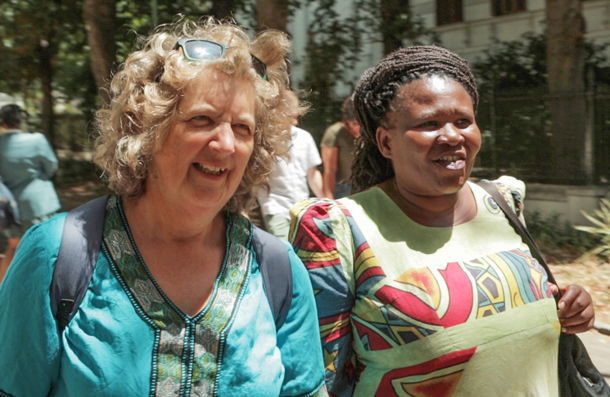
Makoma and Liz are long-time community activists and friends. (Photo: Goldman Environmental Prize)
MCDAID: Well, if we look at those blackouts, and some of us have also had suspicions around it, but we ended up as suddenly putting all our efforts into a number of coal fired power stations to the point that we now have excess electricity, and if you have excess electricity, even though you built these things, you've got to pay for them. And so, electricity prices have been going up very steeply. Now, you want to bring in a nuclear reactor – not just one, a whole pack of them on one big project - and that would have a huge impact on the electricity price and unneeded.
CURWOOD: So, talk to me about the obstacles you faced in persuading the South African leaders to reject this nuclear deal?
LEKALAKALA: It was basically not really obstacles that we faced much because we knew that what we were doing was the right thing. Our main role was to try and explain to people what this intergovernmental agreement said and why we were finding a court case against the president of the country, why we were filing a case against the department of environment, and also the national energy regulator of South Africa and lately we added Eskom because they came in back door trying to dismiss our case.
CURWOOD: So, South Africa already has a nuclear power station. Tell me about the plant and what have the issues been in managing that plant and the subsequent waste?
MCDAID: Well, yes, we've had a power plant, which is built from the apartheid era Koeberg is right in the bottom corner, right next to the city of Cape Town, and the common knowledge is that when you build nuclear plants generally it's related to nuclear weapons. And South Africa post-democracy closed down its nuclear weapons and this is like a legacy project that we had to deal with for generations because it's creating nuclear waste, it's had a few near misses, and it's very close to a city of four million people, and what we would be looking to do is close it down because nuclear energy is outdated technology, we're going into the future, and the future for Africa can certainly be solar, wind and other renewable sources.
CURWOOD: You know, one thing that struck me about this proposed deal was like nuclear or not it's certainly not the latest or safest technology that they were going to buy.
MCDAID: Well, when you when you think of what resources we have in terms of one of the highest solar resources in the world, we think of the trends globally, then when you start looking at where nuclear is going, it seems to us that this is another instance of attempts to dump technology that's outdated onto the developing world. So, certainly nuclear shouldn't be part of an energy mix in our view.
CURWOOD: So, what was your approach? You decided to protest, you went out, you hired lawyers to sue. How did you respond?
LEKALAKALA: We had a multi-pronged strategy. I think at the first go, we never wanted to go to court. That was something far-fetched for us. All we needed was to have engagement with the bureaucrats within the government departments. We wanted to understand, to have a dialogue, a discussion, so that we could come to a common understanding, but unfortunately that was not opened to us, and we had protests, we had petitions written, we had demonstrations, we had marches. In Johannesburg, we had continuous pickets at the Department of Energy. They were a multi-pronged strategy. We used to go to different organizations – community based organizations, faith based organizations, interest groups – to talk about this issue and also to link up people's interest issues to this nuclear deal.
For example, myself as an ordinary South African, I have an issue with access to electricity. I'm connected to the grid, but a lot of my peers and the women that I live with are unable to purchase electricity. But if we have a decentralized electricity system where either it can be socially owned or where people can have their own kind of mini-grids in their homes, that would be of benefit to a whole lot of people that would improve their lives. Everyone has got a right to to energy.
CURWOOD: You have plenty of sunshine.
LEKALAKALA: We do have plenty of sunshine. That's why we're talking about the decentralized electricity system. That's because we've got alternatives. There is no political will to invest in renewable energy technology though the government has made a commitment internationally to reduce greenhouse gases.
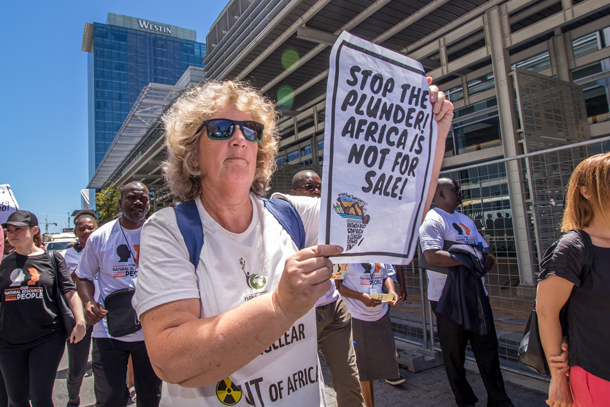
Liz McDaid of the Southern African Faith Communities’ Environment Institute (SAFCEI) at an anti-nuclear deal protest. (Photo: Goldman Environmental Prize)
CURWOOD: So, in the end how did you get this stopped? I gather you got a ruling from the Western Cape High Court, so that's not even the country's highest court.
MCDAID: So, well, the High Court in the Western Cape is one of the senior courts, and if the government had appealed our decision, we would have had to go on to the next, the constitutional court, but fortunately for us our case was really strong and I suppose the basis was, if you follow due process, you follow the law, you would have never come out with a nuclear deal. So, the courts found that the government had acted completely illegally on a whole number of fronts and so they pushed the reset button and said, ‘No, all of this is off the table.’
CURWOOD: So, how do you feel and what kind of legal precedent do you think it set in terms of any future nuclear projects that might crop up there in South Africa?
MCDAID: Well, I think it sends a strong signal to those that would lobby for illegal and corrupt deals, that the judiciary is standing firm, and we hope that the new presidency will uphold that process of the law, and for us I think it was a victory. We felt good that we had achieved this because we would like to see a legacy of a just energy transition and good governance. That's what we were fighting for.
CURWOOD: So, South Africa has shown the way in a number of issues around the world. So, talk to me about what kind of reform needs to take place among nuclear facilities elsewhere. Which existing projects or ones that are in development do we need to be looking out for?
MCDAID: I mean, South Africa, what we've done is – is stopped what to see it be an attempt to push something down our throats to impose a project that wasn't needed and to use nefarious methods to get it right, and we need to be careful that the same thing isn't happening in other African countries, and to share our experience with them so that we can be a united voice and a united front to make sure that what we want is a energy transition communities can own and have power over decisions that affect their lives, and differently when you have large clunky nuclear power stations, you don't have that.
CURWOOD: The two of you were raised in apartheid South Africa. I imagine that growing up under apartheid had some sort of hand in shaping you as an activist.

The Goldman Prize signing ceremony took place on April 23rd in San Francisco. (Photo: Goldman Environmental Prize)
LEKALAKALA: I think we're just continuing with what we lived through and there's values attached to that, I think these are the values that are driving us to continue ensuring that our hard won democracy is protected and the rights that have been won are not reversed. We would not want to see an oppressive government anymore. All what we want is energy justice and energy democracy for the sake of the planet.
MCDAID: Yes, I became an anti-apartheid activist long before I was an environmental activist. Being in that world of ... yeah, fighting a government that was unjust kind of forged you a bit in a way of what one might experience now. So, now we have democracy and we fought for democracy and certainly now working in the environmental justice field for me it was like we can't let that roll back.
CURWOOD: Africa has been saddled with inappropriate energy technology, some would say – huge dams, attempts to build nuclear stations, a lot of coal – in a time when people are moving to carbon-free energy sources. What would you say to folks who are involved in development in Africa about what you've done and what should happen ahead?
MCDAID: So, we really...what I think we're saying is, ‘Don't dump outdated technology on us. Look at what is appropriate for the people of Africa.’ And this is an opportunity for Africa to get ahead of the curve. We've got the renewable energy. People have a say into development, which actually addresses the inequity and the poverty issues in a way that's both environmentally friendly and socially responsible.
LEKALAKALA: Each and every citizen of any country has got a right to hold their government accountable, and that's what we did. We stepped up. We hope that what we did is an example not only to South Africans, but an example to people all over the world that if there's anything wrong that is happening and they know it's wrong, they need to stand up.
CURWOOD: South Africans Makoma Lekalakala and Liz McDaid won this year’s Goldman Environmental Prize for activism in Africa. Thank you both for telling us your story – congratulations!
LEKALAKALA: A pleasure.
MCDAID: Thank you very much.
Related links:
- For more on all the winners, visit the Goldman Prize website
- More on the controversial nuclear deal protests
- Makoma Lekalakala works with EarthLife Africa
- Liz McDaid’s organization, The Southern African Faith Communities’ Environment Institute
CURWOOD: On the next Living on Earth, We bring you the stories of two more Goldman Environmental Prize winners. There’s Manny Calonzo who got lead out of paint in the Philippines.
MANNY: We have read about studies and reports in US about kids being poisoning because of their exposure to lead and, I think, if lead is bad for American children, it must be bad for Filipino children as well.
CURWOOD: And also Claire Nouvian—who worked to ban destructive trawl fishing in the European Union.
NOUVIAN: There are animals in the deep sea such as corals that can live thousands of years and a single fishing net can come and destroy life that took thousands of years to grow. It makes absolutely no sense.
CURWOOD: The stories of more environmental champions – next time on Living on Earth.
[MUSIC: Geoff Muldaur, “Just a Little While To Stay Here” on The Secret Handshake, by E. M. Bartlett, Hightone Records]
CURWOOD: Our crew includes Naomi Arenberg, Bobby Bascomb, Savannah Christiansen, Jenni Doering, Jaime Kaiser, Hannah Loss, Don Lyman, Helen Palmer, Aynsley O’Neill, Adelaide Chen, and Jolanda Omari.
Tom Tyger engineered our show, with help from Jeff Wade and Jake Rego. Alison Lirish Dean composed our themes. You can hear us anytime at L-O-E dot org – and like us, please, on our Facebook page – PRI’s Living on Earth. And we tweet from @livingonearth. I’m Steve Curwood. Thanks for listening!
ANNOUNCER1: Funding for Living on Earth comes from you, our listeners, and from the University of Massachusetts, Boston, in association with its School for the Environment, developing the next generation of environmental leaders. And from the Grantham Foundation for the protection of the environment, supporting strategic communications and collaboration in solving the world’s most pressing environmental problems. Support also comes from the Energy Foundation, serving the public interest by helping to build a strong, clean, energy economy, from Carl and Judy Ferenbach of Boston, Massachusetts and from SolarCity, America’s solar power provider. SolarCity is dedicated to revolutionizing the way energy is delivered by giving customers a renewable alternative to fossil fuels. Information at 888-997-1703. That’s 888-997-1703.
ANNOUNCER 2: This is PRI, Public Radio International.
Living on Earth wants to hear from you!
Living on Earth
62 Calef Highway, Suite 212
Lee, NH 03861
Telephone: 617-287-4121
E-mail: comments@loe.org
Newsletter [Click here]
Donate to Living on Earth!
Living on Earth is an independent media program and relies entirely on contributions from listeners and institutions supporting public service. Please donate now to preserve an independent environmental voice.
NewsletterLiving on Earth offers a weekly delivery of the show's rundown to your mailbox. Sign up for our newsletter today!
 Sailors For The Sea: Be the change you want to sea.
Sailors For The Sea: Be the change you want to sea.
 The Grantham Foundation for the Protection of the Environment: Committed to protecting and improving the health of the global environment.
The Grantham Foundation for the Protection of the Environment: Committed to protecting and improving the health of the global environment.
 Contribute to Living on Earth and receive, as our gift to you, an archival print of one of Mark Seth Lender's extraordinary wildlife photographs. Follow the link to see Mark's current collection of photographs.
Contribute to Living on Earth and receive, as our gift to you, an archival print of one of Mark Seth Lender's extraordinary wildlife photographs. Follow the link to see Mark's current collection of photographs.
 Buy a signed copy of Mark Seth Lender's book Smeagull the Seagull & support Living on Earth
Buy a signed copy of Mark Seth Lender's book Smeagull the Seagull & support Living on Earth

